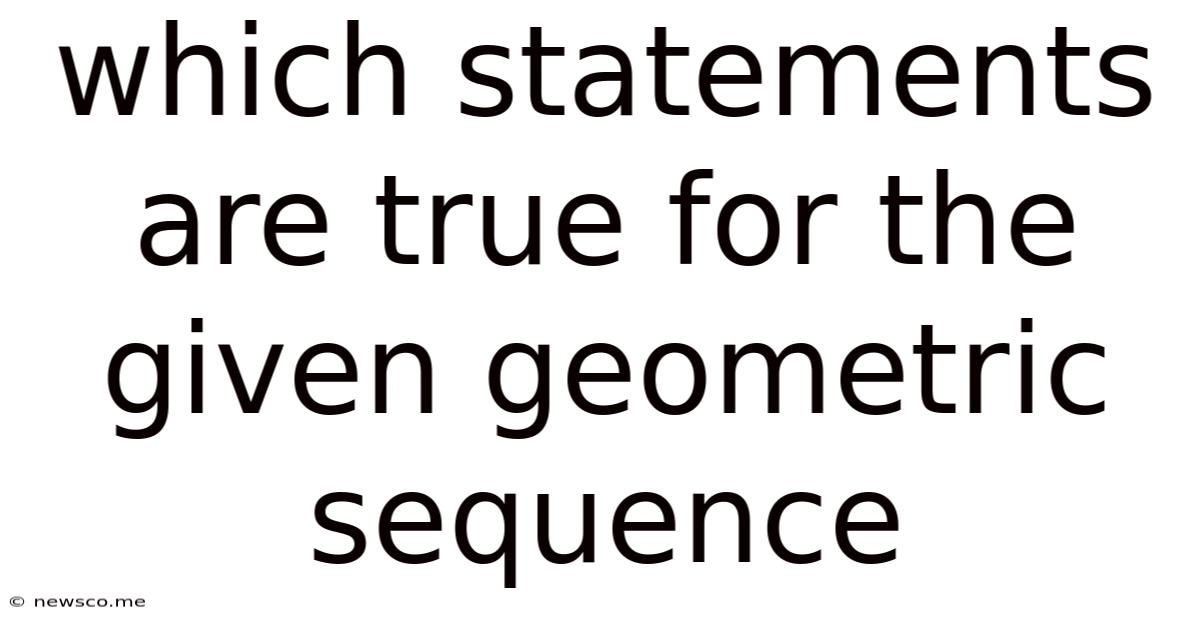Which Statements Are True For The Given Geometric Sequence
News Co
May 08, 2025 · 5 min read

Table of Contents
Which Statements Are True for the Given Geometric Sequence? A Deep Dive into Geometric Progressions
Geometric sequences, a cornerstone of mathematics, possess unique properties that distinguish them from other sequences. Understanding these properties is crucial for solving a variety of mathematical problems, from simple calculations to complex applications in fields like finance and computer science. This article delves into the characteristics of geometric sequences, focusing on identifying true statements related to a given sequence. We'll explore common pitfalls and provide a comprehensive guide to accurately determining the validity of statements concerning geometric progressions.
Understanding Geometric Sequences: The Fundamentals
A geometric sequence, also known as a geometric progression (GP), is a sequence of numbers where each term after the first is found by multiplying the previous one by a fixed, non-zero number called the common ratio (often denoted by 'r'). The first term is denoted as 'a'. The general form of a geometric sequence is:
a, ar, ar², ar³, ar⁴, ...
where:
- a represents the first term.
- r represents the common ratio.
- ar<sup>n-1</sup> represents the nth term of the sequence.
Key Characteristics of Geometric Sequences
Several key characteristics help identify and analyze geometric sequences:
- Constant Ratio: The defining feature is the constant ratio between consecutive terms. Dividing any term by its preceding term always yields the common ratio, r.
- Exponential Growth/Decay: If the common ratio (r) is greater than 1, the sequence exhibits exponential growth. If 0 < r < 1, the sequence exhibits exponential decay. If r is negative, the terms alternate in sign.
- Recursive Definition: A geometric sequence can be defined recursively as: a<sub>n</sub> = r * a<sub>n-1</sub>, where a<sub>n</sub> is the nth term and a<sub>n-1</sub> is the (n-1)th term.
- Explicit Formula: The nth term can be calculated directly using the explicit formula: a<sub>n</sub> = a * r<sup>n-1</sup>. This formula is incredibly useful for finding any term in the sequence without calculating all the preceding terms.
Identifying True Statements: A Step-by-Step Approach
Let's consider a sample geometric sequence and analyze statements related to it. Suppose our geometric sequence is: 2, 6, 18, 54, 162, ...
In this sequence:
- a (first term) = 2
- r (common ratio) = 3 (6/2 = 3, 18/6 = 3, and so on)
Now, let's evaluate several statements about this sequence:
Statement 1: The 7th term is 1458.
To verify this, we use the explicit formula: a<sub>n</sub> = a * r<sup>n-1</sup>
For the 7th term (n=7): a<sub>7</sub> = 2 * 3<sup>7-1</sup> = 2 * 3<sup>6</sup> = 2 * 729 = 1458.
Therefore, Statement 1 is TRUE.
Statement 2: The sum of the first five terms is 484.
The sum of the first n terms of a geometric sequence is given by the formula:
S<sub>n</sub> = a(r<sup>n</sup> - 1) / (r - 1) (for r ≠ 1)
For the sum of the first five terms (n=5):
S<sub>5</sub> = 2(3<sup>5</sup> - 1) / (3 - 1) = 2(243 - 1) / 2 = 242
Therefore, Statement 2 is FALSE.
Statement 3: The common ratio is 2.
We already calculated the common ratio to be 3.
Therefore, Statement 3 is FALSE.
Statement 4: The sequence is a decreasing sequence.
Since the common ratio (r=3) is greater than 1, the sequence is increasing, not decreasing.
Therefore, Statement 4 is FALSE.
Statement 5: The 10th term is divisible by 9.
Let's find the 10th term: a<sub>10</sub> = 2 * 3<sup>10-1</sup> = 2 * 3<sup>9</sup> = 2 * 19683 = 39366
39366 / 9 = 4374
Therefore, Statement 5 is TRUE.
Statement 6: The ratio of the 6th term to the 4th term is 9.
The 6th term is 2 * 3<sup>5</sup> = 486. The 4th term is 2 * 3<sup>3</sup> = 54.
486 / 54 = 9
Therefore, Statement 6 is TRUE.
Statement 7: The sequence can be written as 2 * 3<sup>n-1</sup>, where n represents the term number.
This statement represents the explicit formula for the sequence. Substituting any value for 'n' will give you the corresponding term in the sequence.
Therefore, Statement 7 is TRUE.
Advanced Considerations and Common Mistakes
When analyzing geometric sequences, be mindful of these points:
- Infinite Geometric Series: If |r| < 1, the infinite geometric series converges to a sum given by a / (1 - r). If |r| ≥ 1, the series diverges (the sum is infinite). Understanding convergence and divergence is essential for dealing with infinite geometric series.
- Negative Common Ratios: Sequences with negative common ratios alternate between positive and negative terms. This can lead to confusion if not handled carefully.
- Zero Terms: A geometric sequence cannot contain zero unless the first term is zero, in which case all subsequent terms are zero.
- Fractional Common Ratios: Working with fractional common ratios requires careful attention to calculations.
Conclusion: Mastering Geometric Sequence Analysis
Analyzing statements related to geometric sequences requires a thorough understanding of the fundamental concepts and formulas. By carefully applying the explicit formula, sum formula, and understanding the implications of the common ratio, you can accurately determine the truth value of any statement concerning a given geometric progression. Remember to pay close attention to the common ratio's sign and magnitude, and always double-check your calculations. Through consistent practice and a solid grasp of the underlying principles, you can develop the skills needed to confidently tackle problems involving geometric sequences. This ability is invaluable not just in mathematical contexts but also in various fields that utilize exponential growth and decay models.
Latest Posts
Related Post
Thank you for visiting our website which covers about Which Statements Are True For The Given Geometric Sequence . We hope the information provided has been useful to you. Feel free to contact us if you have any questions or need further assistance. See you next time and don't miss to bookmark.